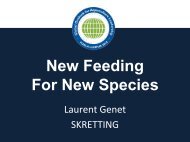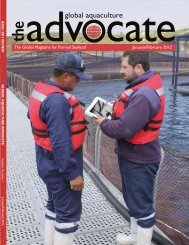May/June 2010 - Global Aquaculture Alliance
May/June 2010 - Global Aquaculture Alliance
May/June 2010 - Global Aquaculture Alliance
You also want an ePaper? Increase the reach of your titles
YUMPU automatically turns print PDFs into web optimized ePapers that Google loves.
Burimy installed a variable slurry ice system to provide constant,<br />
low-temperature cooling throughout the harvesting and<br />
processing cycle, ensuring the preservation of its fillets and<br />
dressed products. The system uses 20° C seawater to produce as<br />
much as 6.6 mt of dry ice crystals or 18.5 mt of slurry ice daily.<br />
Burimy wanted to improve quality and improve working efficiency.<br />
The slurry system allowed the company to maintain a<br />
consistent fish product temperature at just below 0° C from harvesting<br />
all the way to shipping.<br />
Before installing the system, Burimy used a crushed ice and<br />
seawater mixture for bleeding fish at the farm and chilling in the<br />
processing plant. Early in the morning, two employees stirred ice<br />
and water in the bleeding tanks for two hours. They then moved<br />
the tanks to the dock and loaded them on the boat that would carry<br />
them to the offshore fish cages 15 minutes away.<br />
With the ice slurry system, the process is as simple as pressing<br />
a button to pump the ice from the insulated storage tank next to<br />
the processing plant to the tanks on the dock, about 180 m away.<br />
The ice is delivered with a temperature of -1.7° C.<br />
The fish are loaded onto the operating boat at the farm and<br />
killed quickly with a bleeding machine. When initially placed in<br />
the onboard tank, the fish have a temperature of 16° C.The load<br />
is then placed into tanks on the dock containing slurry with a 25<br />
to 30% ice fraction.<br />
The holding tanks are delivered to the processing plant,<br />
where the fish cool for an additional hour to 4° C. Even with the<br />
fish in the tank, the temperature of the ice remains at -1.5° C.<br />
The fish are processed, cleaned and once again placed in<br />
slurry ice for an additional 30 minutes to bring the fish temperature<br />
down to 0° C. The fillets and ready-to-cook fish are dried<br />
off, packed and shipped.<br />
Variable-state ice slurry systems can generate product of varied<br />
consistency by controling both the ice fraction and salinity of<br />
the discharged slurry.<br />
Mussel Processing<br />
Other applications of slurry ice extend from shrimp and<br />
salmon to mussel cooling and packing operations. In late 2005,<br />
Prince Edward Aqua Farms Inc. joined other mussel packers on<br />
Prince Edward Island and integrated a slurry system into its<br />
existing processing facilities. Slurry ice is used to pack the mussels<br />
and ship them fresh to markets across North America.<br />
Jerry Bidgood, general manager of Price Edward Aqua Farms,<br />
said: “We wanted an ice system that was fast-cooling, slow-melting<br />
and more efficient than our flake ice system. Our goal was to<br />
reduce drip loss and increase shelf life by maintaining a colder<br />
core temperature, especially during the mussel-spawning season<br />
in <strong>June</strong> and July.”<br />
The system at Price Edward Aqua Farms uses seawater to<br />
produce as much as 10 mt of dry ice or almost 20 mt of slurry ice<br />
per day. Slurry with an ice fraction of 50 to 60% is automatically<br />
pumped to four locations at the facility.<br />
At the first two locations, slurry ice is discharged into bulk<br />
containers holding 360 to 410 kg of mussels packaged in mesh<br />
bags. The mussels are cooled to just above 0° C. Bidgood said the<br />
earlier flake ice system required a lot of manual labor, as ice had<br />
to be shoveled into every box and vat.<br />
“The (slurry) system gave us an automatic method for icing<br />
that got in between every mussel in every bag, ensuring fast cooling<br />
of the entire product,” Bidgwood said. “Comments from our<br />
customers are extremely positive, and they don’t wish to go back<br />
to flake ice.”<br />
A third discharge location is a chill room used for packing<br />
mussels in waxed boxes in 50-, 25- or 10-lb (22.6-, 11.3- or 4.5kg)<br />
configurations. Mesh bags of mussels are placed into the<br />
boxes, and ice slurry is discharged over the bags, flowing into<br />
every space to provide ultimate contact cooling. The final discharge<br />
station is also located in the chill room, over 45 m away<br />
from the ice generators. It is used for packing the bulk containers<br />
and waxed boxes, and as a re-icing station to maintain mussels<br />
packed on non-shipping days.<br />
“Our customers tell us they can get 10 to 12 days shelf life<br />
with our mussels in (slurry) ice,” Bidgwood said. “They say they<br />
can only get seven days from our competitor’s product that uses<br />
other types of ice.”<br />
innovation<br />
Ultrasound Helps Stage<br />
Sturgeons For Caviar<br />
Production<br />
Caviar eggs removed<br />
from the abdomen of<br />
a mature female white<br />
sturgeon.<br />
Summary:<br />
Biopsies and polarization index<br />
measurements of mature sturgeons<br />
are highly variable and not<br />
always accurate in indicating egg<br />
maturity. Ultrasonic imaging<br />
offers a simple, less time-consuming<br />
and reliable alternative<br />
for evaluating sturgeons’ sex and<br />
oocyte maturity. Research by the<br />
authors found ultrasound an accurate,<br />
non-invasive method for<br />
sexing sturgeons and assessing<br />
egg ripeness.<br />
Currently, the only means of sexing<br />
sturgeons and measuring oocyte maturity<br />
involves biopsying the reproductive tissue<br />
of mature sturgeons and measuring its<br />
oocyte polarization index (P.I.). P.I. is<br />
the measure of the position of the germinal<br />
vesicle (nucleus) relative to the animal<br />
pole. Initial P.I. measurements are used<br />
to determine when during the year the<br />
eggs will reach spawning readiness. Generally,<br />
optimal caviar yield and quality are<br />
reached when the P.I. is 0.10 to 0.12.<br />
Biopsying requires anesthetizing the<br />
sturgeons. It is a labor-intensive and<br />
invasive procedure in which a 1-cm inci-<br />
sion is made along the abdominal wall,<br />
and gonad tissue is aspirated. Consequently,<br />
this procedure stresses the fish<br />
and results in scarring and other undesirable<br />
effects.<br />
Due to the time-consuming nature of<br />
these procedures, biopsy and P.I. measurements<br />
are generally only performed<br />
once in the fall to predict the timing of<br />
oocyte harvest the following winter and<br />
spring. However, P.I. measurements are<br />
highly variable among mature females<br />
and are not always an accurate predictor<br />
of egg maturity, often resulting in<br />
improper timing of harvests, decreasing<br />
caviar yield and quality, and increasing<br />
rates of resorption of eggs.<br />
Additional methods of staging oocyte<br />
ripeness are necessary. These methods<br />
should be more reliable, non-invasive<br />
and, if possible, less time-consuming.<br />
Ultrasound<br />
For many years, ultrasound has been a<br />
valuable tool in the medical field and terrestrial<br />
animal agriculture for non-invasively<br />
assessing soft tissue within live animals.<br />
Ultrasound is a cyclic sound<br />
pressure with a frequency of roughly 20<br />
kHz or greater. As the wave energy<br />
passes through tissues, energy is scattered,<br />
absorbed or reflected back to the<br />
Brian C. Donahower, Ph.D.<br />
University of Idaho<br />
Hagerman Fish Culture Experiment<br />
Station<br />
3059F National Fish Hatchery Road<br />
Hagerman, Idaho 83332 USA<br />
donahower@uidaho.edu<br />
Steve DuMond<br />
Leo Ray<br />
Linda Lemmon<br />
Gary Fornshell<br />
Terry Patterson<br />
Jodi Rockett<br />
Madison S. Powell<br />
Wendy M. Sealey<br />
transducer depending on the properties<br />
of the tissue and the relative changes of<br />
those properties between tissues.<br />
Ultrasound is most commonly used as<br />
a medical diagnostic tool to visualize internal<br />
body tissues, such as muscles, tendons<br />
and organs. Additionally, ultrasonic imaging<br />
(sonography) is a valuable technique<br />
for determining gestational age and fetal<br />
viability. Ultrasonic imaging offers advantages<br />
over magnetic resonance imaging<br />
and computed tomography scans that<br />
include relative portability, straightforward<br />
operation and lower costs.<br />
Oocyte Study<br />
In a study, the authors assessed the<br />
utilization of ultrasound in determining<br />
both the sex and oocyte maturity in adult<br />
white sturgeons. To accomplish this, a<br />
portable, waterproof ultrasound machine<br />
was used. Transverse and sagittal ultrasonic<br />
images were captured at multiple<br />
sections along the left and right abdominal<br />
walls between the pectoral and pelvic<br />
fins of 54 adult female white sturgeons<br />
and four adult male white sturgeons.<br />
Among the female fish, 30 were identified<br />
as having a distinct, mature egg mass<br />
in both the transverse and sagittal planes.<br />
These findings were confirmed by biopsy.<br />
Furthermore, egg size from each mature<br />
female sturgeon was calculated using the<br />
measuring tool on the ultrasound device<br />
and compared to measurements taken following<br />
biopsy, leading to mixed results.<br />
The female sturgeons that did not display<br />
clear signs of a mature egg mass were<br />
found to have immature or atretic eggs,<br />
which was also confirmed by biopsy.<br />
84 <strong>May</strong>/<strong>June</strong> <strong>2010</strong> global aquaculture advocate global aquaculture advocate <strong>May</strong>/<strong>June</strong> <strong>2010</strong> 85





